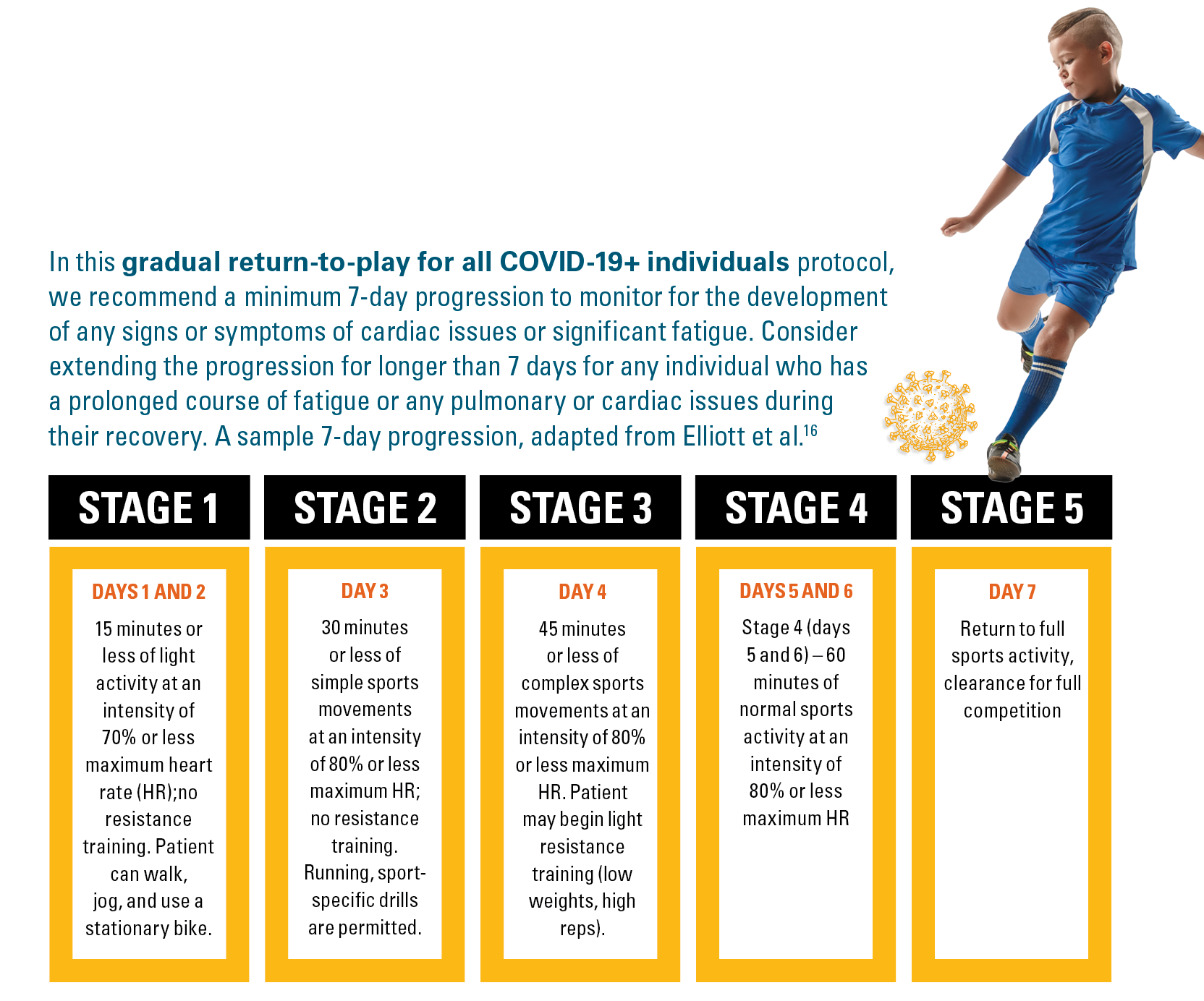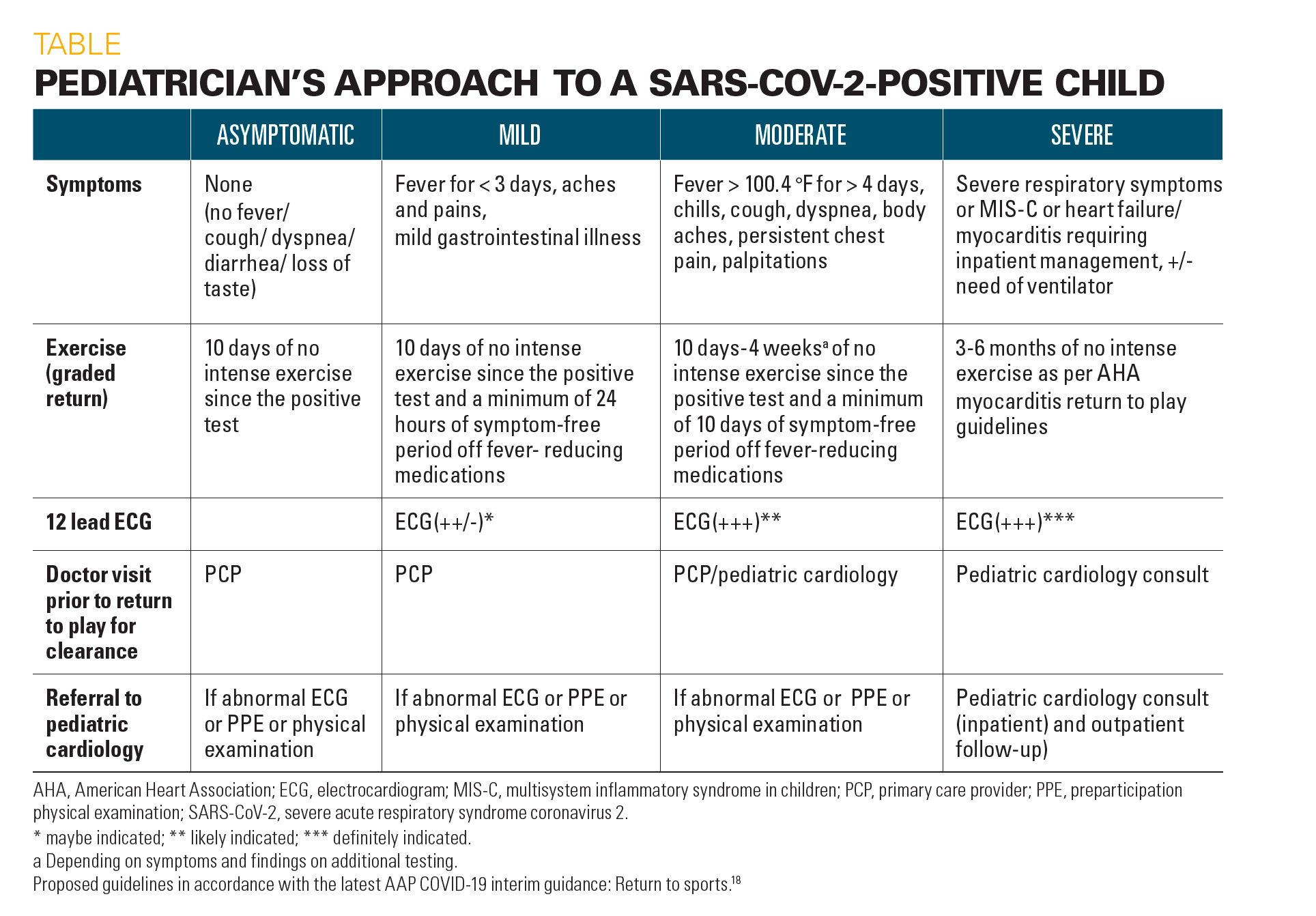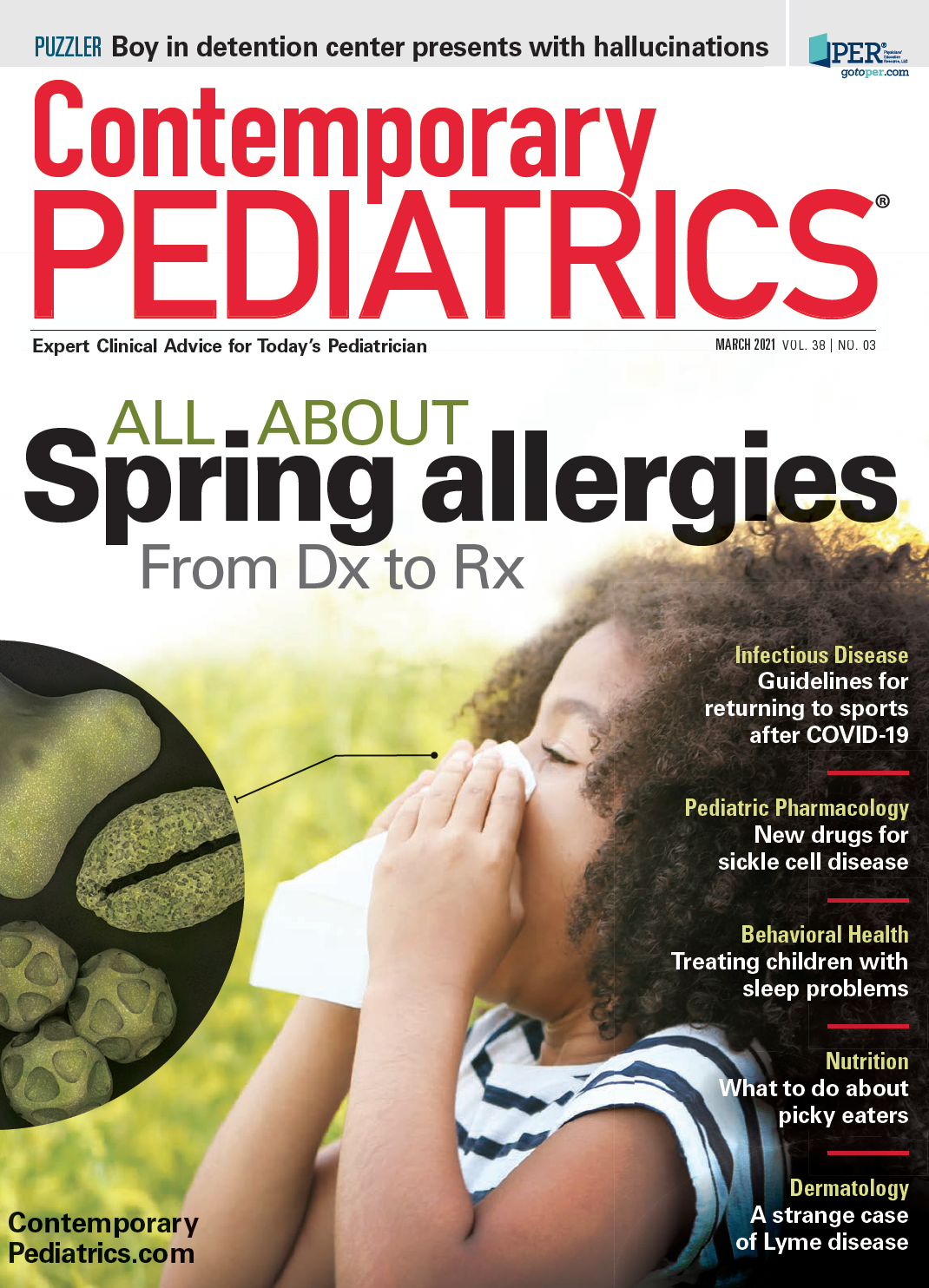Return to sports for adolescents and children after recovery from COVID-19
Coronavirus 2019 disease (COVID-19) is often mild, but can lead to cardiovascular harm. Ensuring the safe return to sports by affected children will be a necessity.
The coronavirus disease 2019 (COVID-19) pandemic has had a major impact on our delivery of health care. It has also affected economic systems, global politics, and our quality of life, especially for children and particularly those involved in sports. In the United States alone, over 35 million children and adolescents participate in athletic endeavors, and social distancing requirements and the immediate halting of large gatherings has negatively affected their physical and psychological health. With the return to school, sporting events are resuming under the watchful eyes of local or state governments, which often seek guidance from medical organizations, sporting bodies, and the Centers for Disease Control and Prevention in formulating regulations. We propose the following recommendations for the safe return of children to all athletic participation (including gym class and heavy chores), after severe acute respiratory syndrome coronavirus 2 (SARS-CoV-2) infection, to assist pediatricians and primary care providers (PCPs) in making the safest decisions for their patients.
Pediatric COVID-19 rarely results in severe systemic problems such as myocardial injury, arrhythmias, kidney failure, or stroke. However, effects on the cardiovascular system have been reported in children who are positive for SARS-CoV-2,1-4 which may occur as part of multisystem inflammatory syndrome in children (MIS-C).5-9 Pediatricians also have seen many of these effects even in children with no overt symptoms,10 the majority of which present weeks after the acute infection when the children would have completed quarantine and resumed sports.11,12 Post COVID-19, the risk of developing serious complications such as MIS-C or cardiac complications such as myocarditis, arrhythmias, and heart failure is a cause of concern for the athlete, their parents, physicians, school boards, and sports licensing groups.
Children who are positive for SARS-CoV-2, even those who are asymptomatic, are at risk for developing myocardial injury. Previous reports illustrated that exercise in patients who are positive for COVID-19 can increase viral replication within the cardiac muscle. This leads to structural damage to the heart, directly resulting in ventricular dysfunction, arrhythmias, and, in rare cases, sudden death.1 To date, the risk of pediatric patients positive for SARS-CoV-2 developing myocardial damage is unknown, but it has been reported.1-4 However, data are not available to present a calculated risk number for myocardial injury in these patients. This risk of myocarditis, although rare, is a concern, and hence the need for guidance from medical societies and certifying boards with regard to allowing children who are positive for SARS-CoV-2 to return to sports.
All children and adolescents who are SARS-CoV-2 positive, once asymptomatic, should seek clearance from their PCP prior to returning to athletic participation. This visit should occur after they are asymptomatic for a minimum of 24 hours off fever-reducing medicine, and have completed their 10-day quarantine period.12 The visit should involve a (re-)evaluation of the local preparticipation questionnaire with a comprehensive physical exam. The PCP should pay specific attention to the parts of the questionnaire that are pertinent to cardiac symptoms, such as episodes of chest pain, shortness of breath, exertional dizziness, excessive fatigue out of proportion for a viral upper respiratory infection, and new onset syncope and palpitations during the patient’s infection or recovery. Gastrointestinal symptoms such as early satiety, abdominal pain, nausea, and anorexia can sometimes warrant an evaluation for heart failure.13 Any new history or physical exam findings at this visit should prompt referrals and further testing.
Additional testing
The electrocardiogram (ECG) used in this situation is a screening tool for myocardial injury. It has low sensitivity and an unknown specificity; however, it is readily available to health care providers. It is important to seek accurate, age-appropriate interpretation by a physician familiar with interpreting the subtleties of the pediatric ECG. Findings that should raise concerns of myocardial injury include any dysrhythmia, tachycardia, conduction delays, ST or T wave changes not including early repolarization, and low-voltage QRS complexes.14 As we illustrate in the Table, a patient with an abnormal ECG should be referred to a pediatric cardiologist for further evaluation. Further noninvasive testing includes a 24-hour Holter monitor and an exercise stress test; both of these detect arrhythmias during vigorous activity.
Stages of gradual return-to-play

Many pediatric patients who are positive for COVID-19 and who have severe symptoms, particularly those with MIS-C, will undergo an echocardiogram (ECHO) during their acute hospitalization.1 An ECHO assesses cardiac function and looks for evidence of fluid around the heart and leakage from any of the heart valves. It can also evaluate the proximal coronary arteries for dilation. If there is continued suspicion of myocardial involvement from the patient’s history, physical examination, or any of the other testing, advanced imaging with a cardiac magnetic resonance imaging may be performed. This highly specialized test can show changes in the heart muscle even months after the illness.
Biomarkers, such as troponin I, are indicators of myocardial involvement and when elevated often indicate myocardial injury.15 Routine testing for biomarkers in all children positive for SARS-CoV-2 is not required; such tests are used only if there is high clinical concern of cardiac involvement. In this age group, physicians must exercise caution when interpreting this test; biomarker elevation alone cannot constitute a diagnosis of myocardial injury as biomarkers can be elevated in patients after vigorous exercise or local trauma.
Approach to the return to play
The Table shows our recommendations for an approach for PCPs to provide patient clearance for a safe return to play.
To facilitate the safe return to sports, despite the lack of data, we recommend that all patients who are SARS-CoV-2 positive refrain from exercise for a minimum of 10 days after the positive test result. Those who are asymptomatic or have mild symptoms (≤ 3 days of fever, aches, and pains; mild gastrointestinal illness) may begin a gradual return after 10 days in quarantine; a minimum time of 24 hours, symptom free, off fever-reducing medicine has passed; and they have been cleared by a physician.
Table

For those with moderate symptoms (fever, >100.4 °F for 4 or more days; chills, cough, dyspnea, body aches, persistent chest pain, or palpitations), consider their having a 12 lead ECG prior to returning to athletic activities. In a child who is SARS-CoV-2 positive, a normal ECG suggests that direct cardiac involvement is less likely. The PCP can give clearance to a patient for a gradual, safe return to sports after 10 days in quarantine and a minimum of 10 symptom-free days have passed while they are off fever-reducing medicine. After returning to sports, patients should be monitored for presence of symptoms and, if required, be re-evaluated by their physician. Pediatric patients who are hospitalized due to moderate-severe COVID-19 or MIS-C and/or have overt symptoms of myocarditis or heart failure should be treated according to existing guidelines of the American Heart Association and the American College of Cardiology for myocarditis.17 We note that COVID-19–related myocardial injury may be different from the typical viral myocarditis referred to in the guidelines, but in the absence of data, this approach is prudent. This may include a halt on all exercise for up to 3 to 6 months, depending on the individual pediatric patient. A pediatric cardiologist should evaluate these patients to further assist with guidance regarding their return to sports.
Our proposed guidelines are in accordance with the latest American Academy of Pediatrics (AAP) COVID-19 interim guidelines on returning to sports.18
These guidelines suggest that children who are asymptomatic or have mild symptoms should undergo a thorough evaluation by a physician. The evaluation should include a complete physical exam and a preparticipation screen with particular attention to cardiac symptoms. Patients with unremarkable findings can gradually return to sports 10 days after testing positive for SARS-CoV-2, with at least a 24-hour symptom-free period off fever-reducing medications. However, those with concerning findings will need further evaluation, such as an ECG and a pediatric cardiologist consultation. Children with moderate symptoms or those who have been admitted for nonintensive care to the hospital should receive an ECG and be evaluated by a pediatric cardiologist with additional testing. If the patient has a normal cardiac workup, they can gradually return to sports 10 days after testing positive for SARS-CoV-2, with at least 10 days of symptom resolution off fever-reducing medication. Those children who suffer from severe COVID-19 or MIS-C should refrain from exercise for 3 to 6 months, and they require extensive cardiac testing and cardiology clearance before resuming. The AAP further emphasizes that the return to play should be gradual and occur over 5 stages; patients should begin with 15 minutes or less of less intense activity in the first 2 days, gradually reaching full activity after 7 days.18
For symptomatic individuals, including those with chest pain, palpitations, breathlessness, exertional dizziness, or syncope, a normal ECG may not rule out myocardial injury and they will require close observation for worsening of symptoms. Consider referring these patients to a pediatric cardiologist for evaluation and further testing depending on ECG abnormalities and severity of symptoms, even in the absence of ECG changes. Physicians can often determine the significance and association of these symptoms regarding SARS-CoV-2 infection based on additional tests such as an ECHO or a Holter monitor. The patient’s gradual return to physical activity may be permitted after 10 days to 4 weeks, depending on symptoms and findings.
Conclusion
Patients who test positive for SARS-CoV-2 are at risk of developing myocardial injury, which varies greatly in its clinical presentation. Clinicians should be aware of the possibility of cardiac complications, including sudden death following vigorous exercise secondary to underlying myocardial injury. We recommend that patients are evaluated by a physician prior to returning to sport.
References
- Grimaud M, Starck J, Levy M, et al. Acute myocarditis and multisystem inflammatory emerging disease following SARS-CoV-2 infection in critically ill children. Ann Intensive Care. 2020;10(1):69. doi:10.1186/s13613-020-00690-8
- Trogen B, Gonzalez FJ, Shust GF. COVID-19-associated myocarditis in an adolescent. Pediatr Infect Dis J. 2020;39(8):e204-e205. doi:10.1097/INF.0000000000002788
- Lara D, Young T, Del Toro K, et al. Acute fulminant myocarditis in a pediatric patient with COVID-19 infection. Pediatrics. 2020;146(2):e20201509. doi:10.1542/peds.2020-1509
- Kishore R, Choudekar A, Xess AB, et al. Dilated cardiomyopathy in a child with COVID-19. Indian J Pediatr. Published online October 10, 2020. doi:10.1007/s12098-020-03524-4
- Belhadjer Z, Méot M, Bajolle F, et al. Acute heart failure in multisystem inflammatory syndrome in children (MIS-C) in the context of global SARS-CoV-2 pandemic. Circulation. 2020;142(5):429-436. doi:10.1161/circulationaha.120.048360
- Riphagen S, Gomez X, Gonzalez-Martinez C, Wilkinson N, Theocharis P. Hyperinflammatory shock in children during COVID-19 pandemic. Lancet. 2020;395(10237):1607-1608. doi:10.1016/S0140-6736(20)31094-1
- Whittaker E, Bamford A, Kenny J, et al; PIMS-TS Study Group and EUCLIDS and PERFORM Consortia. Clinical characteristics of 58 children with a pediatric inflammatory multisystem syndrome temporally associated with SARS-CoV-2. JAMA. 2020;324(3):259-269. doi:10.1001/jama.2020.10369
- Ramcharan T, Nolan O, Lai CY, et al. Paediatric inflammatory multisystem syndrome: temporally associated with SARS-CoV-2 (PIMS-TS): cardiac features, management and short-term outcomes at a UK tertiary paediatric hospital. Pediatr Cardiol. 2020;41(7):1391-1401. doi:10.1007/s00246-020-02391-2
- Belot A, Antona D, Renolleau S, et al. SARS-CoV-2-related paediatric inflammatory multisystem syndrome, an epidemiological study, France, 1 March to 17 May 2020. Euro Surveill. 2020;25(22):2001010. doi:10.2807/1560-7917.ES.2020.25.22.2001010
- Rajpal S, Tong MS, Borchers J, et al. Cardiovascular magnetic resonance findings in competitive athletes recovering from COVID-19 infection. JAMA Cardiol. 2021;6(1):116-118. doi:10.1001/jamacardio.2020.4916
- Madjid M, Safavi-Naeini P, Solomon SD, Vardeny O. Potential effects of coronaviruses on the cardiovascular system: a review. JAMA Cardiol. 2020;5(7):831-840. doi:10.1001/jamacardio.2020.1286
- Kim JH, Levine BD, Phelan D, et al. Coronavirus disease 2019 and the athletic heart: emerging perspectives on pathology, risks, and return to play. JAMA Cardiol. Published online October 26, 2020. doi:10.1001/jamacardio.2020.5890
- Sundaram V, Fang JC. Gastrointestinal and liver issues in heart failure. Circulation. 2016;133(17):1696-1703. doi:10.1161/CIRCULATIONAHA.115.020894
- Sharma S, Drezner JA, Baggish A, et al. International recommendations for electrocardiographic interpretation in athletes. Eur Heart J. 2018;39(16):1466-1480. doi:10.1093/eurheartj/ehw631.3
- Babapoor-Farrokhran S, Gill D, Walker J, Rasekhi RT, Bozorgnia B, Amanullah A. Myocardial injury and COVID-19: possible mechanisms. Life Sci. 2020;253:117723. doi:10.1016/j.lfs.2020.117723
- Elliott N, Martin R, Heron N, Elliott J, Grimstead D, Biswas A. Infographic. Graduated return to play guidance following COVID-19 infection. Br J Sports Med. 2020;54(19):1174-1175. doi:10.1136/bjsports-2020-102637
- Maron BJ, Udelson JE, Bonow RO, et al; American Heart Association Electrocardiography and Arrhythmias Committee of Council on Clinical Cardiology, Council on Cardiovascular Disease in Young, Council on Cardiovascular and Stroke Nursing, Council on Functional Genomics and Translational Biology, and American College of Cardiology. Eligibility and disqualification recommendations for competitive athletes with cardiovascular abnormalities: Task Force 3: hypertrophic cardiomyopathy, arrhythmogenic right ventricular cardiomyopathy and other cardiomyopathies, and myocarditis: a scientific statement from the American Heart Association and American College of Cardiology. Circulation. 2015;132(22):e273-e280. doi:10.1161/CIR.0000000000000239
- COVID-19 interim guidance: return to sports. AAP. Updated December 17, 2020. Accessed January 14, 2021. https://services.aap.org/en/pages/2019-novel-coronavirus-covid-19-infections/clinical-guidance/covid-19-interim-guidance-return-to-sports/

Newsletter
Access practical, evidence-based guidance to support better care for our youngest patients. Join our email list for the latest clinical updates.